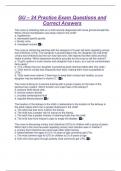-
1. Exam (elaborations) - Peds exam 3 practice questions and correct answers
-
2. Exam (elaborations) - Peds gi/gu sherpath practice questions and correct answers
-
3. Exam (elaborations) - Pediatric exam 3 practice questions and correct answers
-
4. Exam (elaborations) - Exam 2 genitourinary dysfunction review questions and correct answers
-
5. Exam (elaborations) - Peds exam 4- chapters 26, 29, & 30 review questions and correct answers
-
6. Exam (elaborations) - Exam 5 – peds study questions and correct answers
-
7. Exam (elaborations) - Ch 24 genitourinary peds practice questions and correct answers
-
8. Exam (elaborations) - Nurs adn 5 - gi/gu practice questions and correct answers
-
9. Exam (elaborations) - Gu – 24 practice exam questions and correct answers
-
10. Exam (elaborations) - Pediatrics 51 - 52 gi gu test questions and correct answers
-
11. Exam (elaborations) - Peds gu disorders practice exam questions and correct answers
-
12. Exam (elaborations) - Genitourinary disorders practice questions and solutions
-
13. Exam (elaborations) - Chapter 38 pediatric examinations practice questions and correct answers
-
14. Exam (elaborations) - Gi & gu- pediatrics practice test questions and correct answers
-
15. Exam (elaborations) - Pediatric exam 2 study questions and 100% correct answers
-
16. Exam (elaborations) - Peds 4 (gu, musculoskeletal , neuromuscular) review questions and correct answers
-
17. Exam (elaborations) - Evolve - ch. 45 (genitourinary) practice test questions and correct answers
-
18. Exam (elaborations) - Pediatric evolve genitourinary test questions and correct answers
-
19. Exam (elaborations) - Peds gi, gu, musculoskeletal study questions and correct answers
-
20. Exam (elaborations) - Gu practice test questions and complete solutions
-
21. Exam (elaborations) - Crisis 2 peds gi and gu study guide with questions and correct answers
-
22. Exam (elaborations) - Pediatric nursing- gu disorders test questions and correct answers
-
23. Exam (elaborations) - Pediatric gastrointestinal and gu disorders questions and answers
-
24. Exam (elaborations) - Pediatric gi/gu/endocrine practice questions and correct answers
-
25. Exam (elaborations) - Peds - gi, gu, cardiac practice questions and 100% correct answers
-
26. Exam (elaborations) - Gi peds gi, gu, musc (cp, duchenne's) study questions and correct answers
-
27. Exam (elaborations) - Peds gi and gu practice questions and complete solutions
-
28. Exam (elaborations) - Peds prepu chapter 21- nursing care of the child with a genitourinary disorder questi...
-
29. Exam (elaborations) - Gi and gu- pediatrics practice exam questions and correct answers
-
30. Exam (elaborations) - Gi/gu peds sherpath study guide with questions and correct answers
-
31. Exam (elaborations) - Peds gi/gu/endo exam questions and 100% correct answers
-
32. Exam (elaborations) - Pediatric gi/gu study set with questions and correct answers
-
33. Exam (elaborations) - Peds chapter 21 nursing care of the child with a genitourinary disorder questions and...
-
34. Exam (elaborations) - Pediatric gi/gu- exam 3 questions and complete solutions
-
35. Exam (elaborations) - Peds exam 3- gi/ gu practice questions with correct answers and explanations
-
36. Exam (elaborations) - Gu peds- chapter 44 review questions and correct answers
-
37. Exam (elaborations) - Peds success gi/gu review questions and correct answers
-
38. Exam (elaborations) - Pediatrics gi/gu study set with questions and solutions
-
39. Exam (elaborations) - Peds gu practice questions and solutions
-
40. Exam (elaborations) - Gu pediatrics practice questions and solutions
-
41. Exam (elaborations) - Gu-peds practice test questions and correct answers
-
42. Exam (elaborations) - Pediatric gu practice questions and answers
-
Show more




